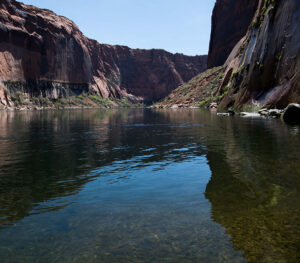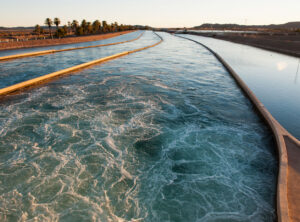The Colorado River is the lifeblood of the Southwest. From the Front Range of the Rockies in Colorado to the metropolises of Southern California, it is Colorado River water that supplies agricultural and residential needs. It is only thanks to the work of the Bureau of Reclamation, however, that this water gets to where it needs to go. Over the last century and more, Reclamation facilities have captured, stored, and delivered the flows of the Colorado, enabling the development of cities like Las Vegas and Phoenix where once there was only desert. In this interview, Reclamation historian Dr. Andrew Gahan tells Hydro Leader about the history behind Reclamation’s development of the Colorado River basin.
Hydro Leader: Please tell us about your background and how you came to be in your current position.
Andrew Gahan: I grew up in Southern California. I began my academic journey somewhat later in life. Prior to becoming a historian, I worked as a pipefitter-welder at two of Chevron Oil’s West Coast refineries. I eventually received my PhD from the University of Nevada, Reno (UNR), where my fields of study were 20th century U.S. history, U.S. cultural history, and public history. All those focused heavily on the history of the American West. I began my career with Reclamation as an intern during my undergraduate years at UNR. My principal responsibilities were researching and writing a two-volume set of Reclamation history, of the second volume of which I was the primary author. It was that work that eventually got me to Denver and into the position I currently hold.
Hydro Leader: Please tell us about the importance of the Colorado River to the Southwest.
Andrew Gahan: The Colorado River wasn’t prominent in public awareness until John Wesley Powell made his epic journey down the river in 1869. Until then, most people looked at the surrounding region as a blank spot on the map of the United States. The West was still sparsely settled, but as its population grew, agriculture became an important component of state and territorial economic growth, and interest in developing the river’s resources increased. Unfortunately, along most of the Colorado River, the topography made reaching those resources difficult, if not practically impossible. The Colorado River is moderately sized compared to some of the other rivers in the United States, but it’s called upon to do a lot, including irrigation, power development, and recreation. The Colorado River is in many ways the lifeblood of the American Southwest.

Hydro Leader: What was the primary trigger for the federal presence on the Colorado River?
Andrew Gahan: Initially, the federal presence on the Colorado River was small. Prior to the construction of Hoover Dam, the Reclamation Service had built only two projects: the Yuma Project along the Arizona-California border and the Grand Valley Project in Colorado. Those were relatively simple diversion projects that served moderately sized irrigation areas.
The seven basin states that share the Colorado River watershed all had an interest in the river and wanted to figure out a way to protect and appropriately divide up its water. Private developers also took an interest in developing the Colorado River, primarily in California’s Imperial Valley. The tremendous growth in the Imperial Valley greatly worried the Colorado Basin states. They were concerned about California’s use of the Colorado River and its implications for any possible developments they might pursue.
Another thing that gave them urgency was the 1922 Supreme Court ruling in Colorado v. Wyoming. The court ruled that the doctrine of prior appropriation applied to interstate streams, regardless of state lines. That decision got the attention of the seven basin states. They got together to establish an equitable distribution of the Colorado River. Representatives of the seven basin states met and signed the Colorado River Compact in 1922. The compact divided the river resources between the upper basin states of Colorado, New Mexico, Utah, and Wyoming and the lower basin states of Arizona, California, and Nevada.
Eventually, the compact led to the passage of the Boulder Canyon Project Act in 1928 and the construction of Hoover Dam and the All-American Canal. This firmly established the federal presence on the Lower Colorado. Additionally, the Boulder Canyon Project Act essentially designated the U.S. secretary of the interior as the Lower Colorado River water master. That gave the federal government an incredibly important role regarding the allocation and distribution of water resources.
Hydro Leader: How big a concern was flood control on the Colorado River?
Andrew Gahan: Initially, that was a major motivation for the construction of Hoover Dam. At the beginning of the 20th century, irrigators in the Imperial Valley used a small diversion dam in Mexico to divert water from the Colorado River. In 1904, the dam failed, and the entire flow of the Colorado River jumped from its bed and started flowing into the Imperial Valley. That went on for 2 years, forming today’s Salton Sea. After 2 years of intense effort, Imperial Valley farmers and the Southern Pacific Railroad closed the breach and returned the Colorado River to its original bed. To avoid another similar disaster, Imperial Valley residents began clamoring for flood control dams somewhere on the Colorado River. Flood control was the central motivation for constructing these dams and canals. At the same time, the residents called for what they termed an All-American Canal, which would eliminate their reliance on water supplies coming from Mexico.
Hydro Leader: Please tell us about some of the major projects on the Colorado River during the 20th century and their role in the development of the Southwest.
Andrew Gahan: The construction of Hoover Dam influenced the whole basin. It initiated development of multipurpose projects that, along with irrigation, contained components to supply water for municipal and industrial purposes, produce hydropower to a wide customer base, and establish flood control and recreation. The Colorado River Compact emerged from the desire of each basin to develop its water resources. Some of the projects in the upper basin, such as the Colorado River Storage Project, were initially constructed to store water to meet the upper basin’s compact obligations and to produce hydropower to aid irrigation development within the region.
There were also major transbasin diversion projects to bring Colorado River water to the Front Range of the Rockies to serve as supplemental supplies and to expand irrigation developments, such as the Colorado–Big Thompson Project. They all had a heavy emphasis on hydropower development.

In short, each basin state sought to use its share of the river. In the late 1960s, the Central Arizona Project was designed and constructed and began to bring Colorado River water to central Arizona communities. Similarly, the Central Utah Project diverted Colorado River water to provide irrigation supplies to the folks in Utah, eventually expanding into the Salt Lake City municipal area and surrounding regions. There was also the R.P. Griffith Project, which uses the entire Nevada allocation of Colorado River water to provide water to the city of Las Vegas and Clark County.
Hydro Leader: What is the historical explanation for why Nevada has the smallest portion of Colorado River water?
Andrew Gahan: I wrote a paper on that. In 1922, when the compact was agreed to, there weren’t really any major irrigated areas in southern Nevada that could use the flows of the Colorado River. There were some small ones that used water resources from Colorado River tributaries like the Muddy River. At the same time, Nevada was the least-populated state in the United States, with barely 100,000 people. Nevada’s political leaders at the time were more interested in power development and the revenues they could potentially gain from the construction of Hoover Dam. Their idea was to sell their power allotment to supplement state revenues. At that time, nobody foresaw the development that would occur in Las Vegas and Clark County after World War II, so securing water resources wasn’t as much of an immediate concern to them as power development. They didn’t see water as a particularly important resource because of the state’s topography and the lack of available arable areas in southern Nevada.
Hydro Leader: What should every Colorado River water user and customer know about Reclamation’s stewardship of the river?
Andrew Gahan: Reclamation’s stewardship of the river goes back to before the construction of Hoover Dam. There was interest in developing the resources of the Colorado River in the best possible manner to benefit the folks living in the Southwest. Today, Reclamation is adopting a consensus-based Drought Contingency Plan that represents the best path forward to safeguard the single most important water resource in the United States. We work tremendously hard with our partners, which include the Colorado River basin states, local and state water agencies, Native American tribes, nongovernmental organizations, and Mexico. We feel we’re succeeding to the best extent we can at reducing the risk from ongoing drought.
I think the biggest takeaway of all this is that the issues that folks were facing at the turn of the 20th century and throughout the 20th century are still the issues folks are facing today. The only change is that this moderately sized river is asked to do so much more, simply because of the exponential increase in demand caused by population growth. The Colorado River is called upon to do much more than it should be able to. Reclamation’s work over the course of the 20th century, the dams it built, and its ability to preserve flows serve as a backbone of water resource savings. Our work on the river is never-ending.
Hydro Leader: What is the historical importance of Reclamation’s work on the Colorado River?
Andrew Gahan: As a historian, I see the water and power resource development on the Colorado River as having helped to drive the industrialization and urbanization of the entire region. Without those facilities, major cities in the Southwest would have been hard pressed to find solutions and resources to meet their growing needs. The federal government’s role in helping to develop Colorado River resources aided the growth of the large urban centers that we see in the Southwest. That’s an incredibly important element of the history of the West, which has gone from being a sparsely settled area to having some of the largest urban centers in the United States. Much of that growth is based on the water resources development of Reclamation.
Andrew Gahan, PhD, manages the Bureau of Reclamation’s History Program. He can be contacted at agahan@usbr.gov or (303) 445‑3314.

